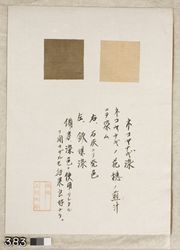Difference between revisions of "Willow bark"
Jump to navigation
Jump to search
| Line 2: | Line 2: | ||
== Description == | == Description == | ||
| − | Bark from black willow trees (''Salix nigra'') native the east coast of the United States. | + | Bark from black willow trees (''Salix nigra'') native the east coast of the United States. The bark from willow trees has been used for medicinal purposes by the Greeks since the 5th century since extracts produce salicylic acid, the presursor of aspirin. additionally the flexible shoots and bark were used for weaving and musical instrument. Extracts of the bark produce a pale brown to rose-tan color on wool using an alum mordant. Willow bark dye has good washfastness and fair lightfastness. Willow bark also contains a natural catechol tanning agent used to prepared leather. |
* For willow dyes, see [[http://cameo.mfa.org/wiki/Category:Uemura_dye_archive '''Uemera Dye Archive''' (Yanagi and Nekoyanagi)]] | * For willow dyes, see [[http://cameo.mfa.org/wiki/Category:Uemura_dye_archive '''Uemera Dye Archive''' (Yanagi and Nekoyanagi)]] | ||
| Line 13: | Line 13: | ||
* John and Margaret Cannon, ''Dye Plants and Dyeing'', Herbert Press, London, 1994 | * John and Margaret Cannon, ''Dye Plants and Dyeing'', Herbert Press, London, 1994 | ||
| − | + | * Wikipedia: https://en.wikipedia.org/wiki/Willow (accessed August 2020) | |
[[Category:Materials database]] | [[Category:Materials database]] | ||
Revision as of 13:42, 16 August 2020
Description
Bark from black willow trees (Salix nigra) native the east coast of the United States. The bark from willow trees has been used for medicinal purposes by the Greeks since the 5th century since extracts produce salicylic acid, the presursor of aspirin. additionally the flexible shoots and bark were used for weaving and musical instrument. Extracts of the bark produce a pale brown to rose-tan color on wool using an alum mordant. Willow bark dye has good washfastness and fair lightfastness. Willow bark also contains a natural catechol tanning agent used to prepared leather.
- For willow dyes, see [Uemera Dye Archive (Yanagi and Nekoyanagi)]
Resources and Citations
- R.J. Adrosko, Natural Dyes in the United States, Smithsonian Institution Press, Washington, DC, 1968
- John and Margaret Cannon, Dye Plants and Dyeing, Herbert Press, London, 1994
- Wikipedia: https://en.wikipedia.org/wiki/Willow (accessed August 2020)

